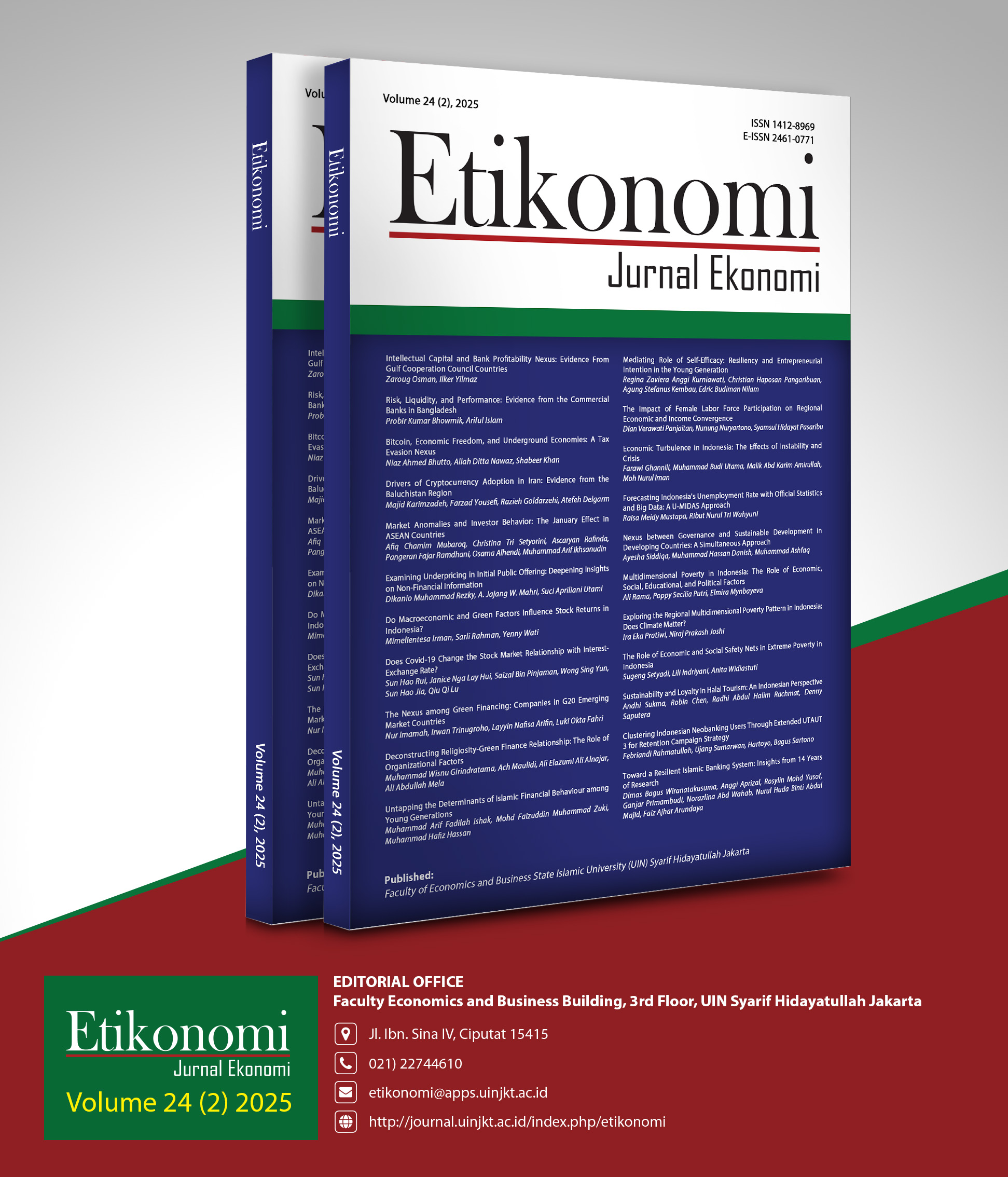Market Anomalies and Investor Behavior: The January Effect in ASEAN Countries
DOI:
https://doi.org/10.15408/etk.v24i2.41491Keywords:
January effect, Stock return, Abnormal return, capital market, efficient market hypothesisAbstract
Research Originality: This study provides a fresh contribution to the literature on market anomalies, specifically the January Effect, within ASEAN capital markets.
Research Objectives: The objective of this research is to investigate the presence and extent of the January Effect by analyzing stock returns and abnormal returns of publicly listed companies in ASEAN capital markets.
Research Methods: Data were obtained through purposive sampling, resulting in a final sample of 153 companies. The research hypotheses were tested using paired sample t-tests.
Empirical Results: The findings indicate that the January Effect is evident in certain capital market indices within ASEAN but is not consistently observed across all markets. The presence of higher stock returns and abnormal returns in January does not conclusively confirm the January Effect in every instance.
Implications: Investors are advised to exercise caution and not rely solely on seasonal anomalies, a comprehensive approach that includes broader market fundamentals and macroeconomic indicators is essential for sound decision-making within ASEAN capital markets.
JEL Classification: E22, F21, G14
Downloads
References
Acha, I. A., & Akpan, S. O. (2019). Capital Market Performance and Economic Growth in Nigeria. Noble International Journal of Economics and Financial Research, 4(2), 10–18.
Alam, M. S., & Hussein, M. A. (2019). The Impact of Capital Market on The Economic Growth in Oman. Financial Studies, 23(2 (84)), 117–129.
Algaeed, A. H. (2021). Capital Market Development and Economic Growth: an ARDL Approach for Saudi Arabia, 1985–2018. Journal of Business Economics and Management, 22(2), 388–409. https://doi.org/10.3846/jbem.2020.13569.
Andrianto, Y., & Mirza, A. R. (2016). A Testing of Efficient Markets Hypothesis in Indonesia Stock Market. Procedia-Social and Behavioral Sciences, 219, 99–103. https://doi.org/10.1016/j.sbspro.2016.04.048.
Anshari, M. R. Y., Putri, Y. E. K. N., Lestari, R. I. O., Fitria, R. M., & Widajatun, V. W. (2020). Market Anomalies: January Effect in Indonesia Stock Exchange and Kuala Lumpur Stock Exchange Period 2015-2019. Solid State Technology, 63(3), 4410–4424.
Ansori, N. D., & Wiagustini, N. L. P. (2018). January Effect on Stock in Jakarta Islamic Index (JII). International Journal of Contemporary Research and Review, 9(12), 21155–21161. https://doi.org/10.15520/ijcrr.v9i12.626.
Arendas, P., Chovancova, B., Kotlebova, J., & Koren, M. (2021). January Anomalies on CEE Stock Markets. Investment Management and Financial Innovations, 18(4), 120–130. https://doi.org/10.21511/IMFI.18(4).2021.11.
Asnawi, S. K., Salim, G., & Malik, W. A. (2020). Does Black Monday Appear on The Indonesia Stock Exchange?. Jurnal Organisasi Dan Manajemen, 16(1), 24–35. https://doi.org/ 10.33830/jom.v16i1.780.2020.
Avdalović, S. M., & Milenković, I. (2017). January Effect on Stock Returns: Evidence from Emerging Balkan Equity Markets. Industrija, 45(4), 13662. https://doi.org/10.5937/industrija45-13662.
Bello, U., Zubairu, U., & Ibrahim, U. A. (2022). Impact of Capital Market Performance on Economic Growth in Developing Nations: A Qualitative Approach. Journal of Service Science and Management, 15(3), 340–349. https://doi.org/10.4236/jssm.2022.153020.
Çakır, M. (2023). Behavioral Finance Analysis of Consumer Confidence in Türkiye. Proceeding of the 15th International Conference on Computing in Economics and Finance, University of Technology in Sidney, Australia.
Cumming, D., Meoli, M., & Vismara, S. (2021). Does Equity Crowdfunding Democratize Entrepreneurial Finance?. Small Business Economics, 56(2), 533–552. https://doi.org/10.1007/s11187-019-00188-z.
Dewi, D. Y., & Santosa, P. W. (2019). Does the January Effect Anomaly Still Exist at Indonesia Stock Exchange ? The International Journal of Business Management and Technology, 3(6), 283–292.
Eduah, N., Debrah, G., Aidoo, E. K., & Mettle, F. O. (2024). Comparative Analysis of Stochastic Seasonality, January Effect and Market Efficiency Between Emerging and Industrialized Markets. Heliyon, 10(7), e28301. https://doi.org/10.1016/j.heliyon.2024.e28301.
Enow, S. T. (2024). Revisiting the January Effect Anomaly: Evidence from International Stock Markets. International Journal of Research in Business and Social Science (2147- 4478), 13(4), 245–251. https://doi.org/10.20525/ijrbs.v13i4.3273.
Evianti, E., Ratnaningrum, N., & Afriany, A. N. (2024). Analysis of the January effect phenomenon in companies included in the LQ45 Stock Index on the Indonesia Stock Exchange for the 2018-2021 period. Proceeding International Conference on Accounting and Finance, 51–62.
Garay Alvarado, M., & Demmler, M. (2019). Analysis of the January Effect in Time Series of Mexican Stock Market Indexes. Mercados y Negocios, 40, 43–62. https://doi.org/10.32870/myn.v0i40.7371.
Ghallabi, F., Bougatef, K., & Mnari, O. (2024). Calendar Anomalies and Asymmetric Volatility of Returns in the Indonesian Stock Market: Conventional vs Islamic Indices. Journal of Islamic Accounting and Business Research, in-press. https://doi.org/10.1108/JIABR-08-2023-0282.
Guo, X. (2022). Research on The January Effect in Healthcare Sector Stock Prices. Highlights in Business, Economics and Management, 4, 127–133. https://doi.org/10.54097/hbem.v4i.3438.
Haataja, A. (2021). Calendar Anomalies: Evidence from Six Emerging Markets. (Unpublished Thesis). University of Houlu.
Kasim, M. Y., Muslimin, & Dwijaya, I. K. B. (2022). Market Reaction to the Covid-19 Pandemic: Events Study at Stocks listed on LQ45 index. Cogent Business & Management, 9(1), 2024979. https://doi.org/10.1080/23311975.2021.2024979.
Kim, J., Doucouliagos, H., & Stanley, T. D. (2019). Market Efficiency in Asian and Australasian Stock Markets: A Fresh Look at The Evidence. IDEAS Working Paper Series. St. Louis Federal Reserve Bank of St. Louis.
Kiprono, E. K. (2018). January Effect on Stock Returns at the Nairobi Securities Exchange Nairobi, Kenya. (Unpublished Thesis). University of Nairobi.
Komariah, S., Nursihab, A., Rimantari, N. E., Juniar, N. A., Herlina, U., & Maulana, F. S. (2022). Market Anomalies: January Effect in Indonesia Stock Exchange, Kuala Lumpur Stock Exchange And National Stock Exchange Of India Period 2016-2020. Central Asia & the Caucasus (14046091), 23(1). https://doi.org/10.37178/ca-c.23.1.299.
Kusuma, M. B., Yanuar, & Cicilia. (2021). January Effect on the Indonesian Stock Market. International Journal of Research Publications, 70(1), 35–45. https://doi.org/10.47119/ijrp100701220211714.
Latifa, N., & Atikah, S. (2024). Testing of the January Effect on The Indonesia Stock Exchange. Asian Journal of Management, Entrepreneurship and Social Science, 4(01), 536–551.
López-Martín, C. (2023). Dynamic Analysis of Calendar Anomalies in Cryptocurrency Markets: Evidences of Adaptive Market Hypothesis. Spanish Journal of Finance and Accounting/Revista Española de Financiación y Contabilidad, 52(4), 559–592. https://doi.org/10.1080/02102412.2022.2131239.
Marisetty, N., & Madasu, P. (2021). Corporate Announcements and Market Efficiency: A Case on Indian Capital Market. International Journal of Business and Management, 16(8), 71. https://doi.org/10.5539/ijbm.v16n8p71.
Maxhuni, D. (2022). January Effect in Finnish Stock Market 2010-2019. (Unpublished Thesis). School of Accounting and Finance.
Miswanto, & Putri, A. A. A. (2023). Investigation Of Winner-Loser Portfolio Anomalies And Size Effect Anomalies In LQ45 Index, Indonesia Stock Exchange. International Journal of Management, 12(4), 602–618. https://doi.org/10.18488/11.v12i4.3558.
Ooi, K. L. (2025). Demystifying Behavioral Finance: Foundational Theories to Contemporary Applications and Future Directions. Berlin: Springer.
Paramita Sarangi, P., & Mohanty, M. (2019). Stock Market Anomalies & Efficiency: Investigatin the January Effect on Indian Equity Market. Ariscom Journal of Management, 1(1), 37–42.
Plastun, A., & Plastun, V. (2018). January Effect: 200 Years of Evolution in the US Stock Market. Geopolitics under Globalization, 2(1), 27–33. https://doi.org/10.21511/gg.02(1).2018.04.
Rahmadan, Z., Yuliusman, R. F., & Friyani, R. (2023). Trading Volume Activity, January Effect, and Stock Splits on Stock Market Returns. Indonesian Journal of Business Analytics (IJBA), 3(06), 2105–2116. https://doi.org/10.55927/ijba.v3i6.5840.
Roni, H. (2022). Calendar Effects In The Hong Kong Stock Market. (Unpublished Thesis). Tallinn University Of Technology.
Rozeff, M. S., & Kinney Jr, W. R. (1976). Capital Market Seasonality: The Case Of Stock Returns. Journal of Financial Economics, 3(4), 379–402. https://doi.org/10.1016/0304-405X(76)90028-3.
Sari, N., Syamsurijal, A. K., & Widiyanti, M. (2018). The Impact Of Islamic Capital Market Development On Economic Growth: The Case Of Indonesia. Journal of Smart Economic Growth, 3(2), 21–30.
Shahid, M. N., & Sattar, A. (2017). Behavior of Calendar Anomalies, Market Conditions and Adaptive Market Hypothesis: Evidence from Pakistan Stock Exchange. Pakistan Journal of Commerce & Social Sciences, 11(2), 110-120.
Shanaev, S., & Ghimire, B. (2021). Efficient Scholars: Academic Attention And The Disappearance Of Anomalies. The European Journal of Finance, 27(3), 278–304. https://doi.org/10.1080/1351847X.2020.1812684.
Solihin, I., Ugut, G. S. S., & Hulu, E. (2022). LQ45 Stock Index Abnormal Return Reaction to the Covid-19 Pandemic: The Event Study Methodology. Indonesian Interdisciplinary Journal of Sharia Economics (IIJSE), 5(1), 342–355. https://doi.org/10.31538/iijse.v5i1.2051.
Szymański, M., & Wojtalik, G. (2020). Calendar Effects in the Stock Markets of Central European Countries. Acta Universitatis Lodziensis. Folia Oeconomica, 5(350), 27–51. https://doi.org/10.18778/0208-6018.350.02.
Tan, Y.-L., & Shafi, R. M. (2021). Capital Market And Economic Growth In Malaysia: The Role Of Ṣukūk And Other Sub-Components. ISRA International Journal of Islamic Finance, 13(1), 102–117. https://doi.org/10.1108/IJIF-04-2019-0066.
Tkalcevic, A., & Schimiedecke, I. K. (2019). The January Effect In The Aftermath Of Financial Crisis Of 2008. Ekonomski Pregled, 557–578. https://doi.org/10.32910/ep.71.6.1.
Tørmoen, T. U., & Vigdel, B. (2021). The January Effect at Oslo Stock Exchange Examining the presence and causes for the January. (Unpublished Thesis). Norwegian University of Science and Technology.
Vochozka, M., Horak, J., & Krulicky, T. (2020). Innovations In Management Forecast: Time Development Of Stock Prices With Neural Networks. Marketing and Management of Innovations, 2, 342-339. https://doi.org/10.21272/mmi.2020.2-24.
Wissawapaisal, K. (2023). Examining the January Effect in Thailand’s Stock Market: A 48-year Journey Since Its Inception. Journal of Innovation in Business, Management, and Social Science, 4(3), 41–51.
Downloads
Published
Issue
Section
License
Copyright (c) 2025 Afiq Chamim Mubaroq, Christina Tri Styorini, Ascaryan Rafinda, Pangeran Fajar Ramdhani, Osama Alhendi, Muhammad Arif Ikhsanudin

This work is licensed under a Creative Commons Attribution-ShareAlike 4.0 International License.










